
While Donald Trump quite regularly refers to either bringing jobs back to America or keeping jobs in America, a paper by Carl Frey and Michael Osborne shows that outsourcing jobs to foreign shores may not be the only mechanism that is keeping Americans unemployment at elevated levels, particularly in manufacturing and the service sector.
In their paper entitled “The Future of Employment: How Susceptible are Jobs to Computerization?“, the authors looked at the probability of computerization for 702 “detailed occupations” with the ultimate goal of looking at the number of jobs at risk in the future and the relationship between an occupation’s probability of computerization, wages and educational level. Using recent advances in machine learning (ML) and mobile robotics (MR), the authors develop a method by which they can categorize the aforementioned 702 occupations by their susceptibility to computerization.
The “Computer Revolution” began in the 1960s with the first commercial use of the massive, room-filling computing machines of the time. The first industrial robot was introduced in the 1960s by General Motors and during the 1980s and 1990s, computing costs declined by an average of 64 percent annually at the same time as computing power surged. Bar code scanners and ATMs became ubiquitous, eliminating some jobs in retail and the banking sector and with the introduction of the first personal computers in the early 1908s, jobs in the clerical world both changed and were eliminated. The adoption of computerization had a significant impact on wages with a 1993 study showing that workers using a computer earning 10 to 15 percent more than other occupations, a situation that sent many Americans (and others) back to school for further education. This has resulted in a polarized labour market with growth in low-income manual occupations that have been resistant to computerization and high-income cognitive jobs and a decline in the number of Americans (and others) employed in middle-income routine jobs. As well, high-skilled workers have moved down the occupational ladder and have taken jobs that were traditionally performed by low-skilled workers, pushing at least some of those low-skilled workers right out of the labour force.
The authors focus on two types of computerization;
1.) machine learning (ML)which includes data mining, machine vision, computational statistics and other fields related to the development of artificial intelligence. Advances in these fields have brought us things like Apple’s Siri which can recognize spoken word and speech recognition/voice response systems which are used in automated call centres.
2.) mobile robotics (MR)which leverages ML technologies so that robotic technology can perform the routine tasks involved in manufacturing. One prime example is the development of driverless vehicles by Google and the development of robots that can climb and maintain wind turbine towers by General Electric.
Over the past decades, robot prices have fallen by about ten percent annually, putting them in the hands of more users. On a global basis, according to the International Federation of Robots, industrial robot sales grew by 15 percent on a year-over-year basis in 2015, hitting a record of 253,748 units with China having a 27 percent share of the total supply in 2015. The biggest growth was in the electronics industry with a 41 percent increase, the metal industry with a 39 percent increase and the plastics and rubber industry with a 16 percent increase.
Now, let’s look at the impact of computerization on employment. Obviously, there are some occupations that will be more difficult to computerize than others due to certain bottlenecks as shown here:
Here is a graphic showing the probability of computerization (low, medium and high) for the Bureau of Labor Statistics occupational groupings:
Note that the jobs of 47 percent of workers in the United States have a high probability of computerization and only 33 percent have a low probability of computerization. In general, science and engineering occupations have a low susceptibility to computerization because they require a high degree of creative intelligence. Occupations including health care, education, management, business and finance, arts and media are also less likely to be computerized because they require a thorough understanding of social intelligence that cannot (at least at this point in time) be duplicated with a robot. The authors suggest that the high probability service,sales, office and administrative support occupations (among others) are likely to find human capital substituted by computer capital relatively soon. As the advantages of human dexterity and mobility diminish as robot evolution progresses, the pace of human – computer labour substitution will grow. Even jobs like personal and household services are increasingly using robots with the market forecast to grow by 23.5 percent annually between 2015 and 2020.
Here are two tables showing the probability of computerization for various wage and educational levels:
As you can see, the probability of computerization rises as median wage drops and as educational attainment drops.
If you are interested in a detailed listing of the probability of computerization for each of the 702 occupations, you can find the listing at the end of the article. Here are two screen captures showing the least susceptible and the most susceptible occupations for your information:
1.) Least susceptible:
2.) Most susceptible:
From this study, we can see that automation/robotics/technology bears and will continue to bear at least some responsibility for the persistence in high real unemployment rates (i.e. not the U-3 rate that is touted by the Bureau of Labor Statistics as its measure of employment health). Unless America’s employers are willing to shun the latest in both machine learning and mobile robotics, employment growth in the United States labour force will continue to be constrained even if overseas jobs are repatriated and Donald Trump successfully keeps some jobs in America.
Click HERE to read more.
You can publish this article on your website as long as you provide a link back to this page.

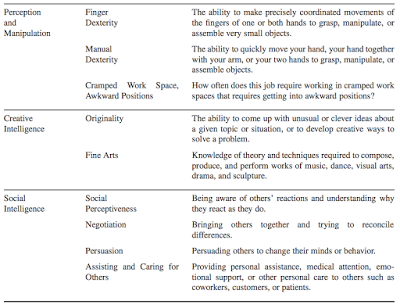
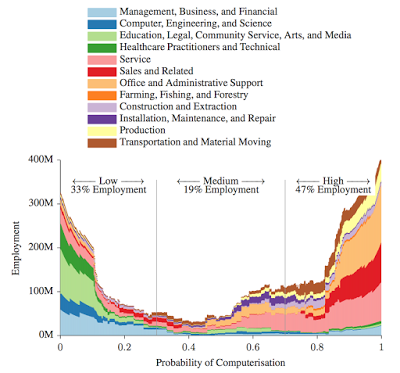
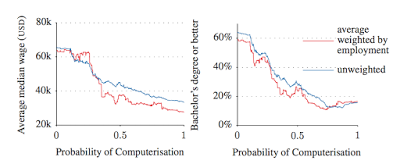
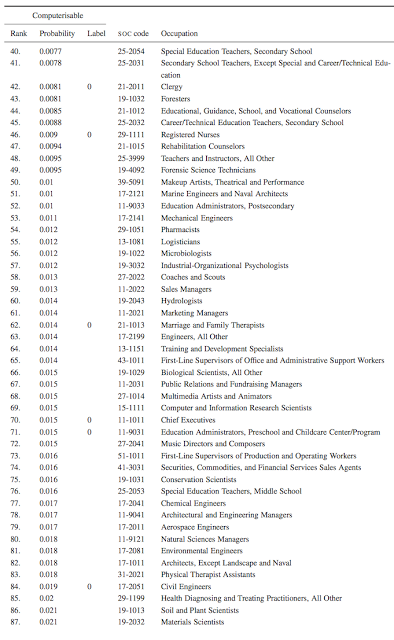
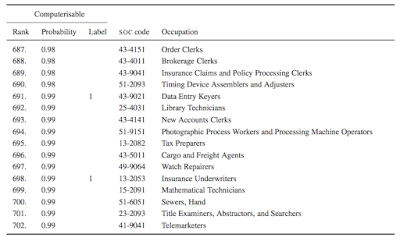
Be the first to comment